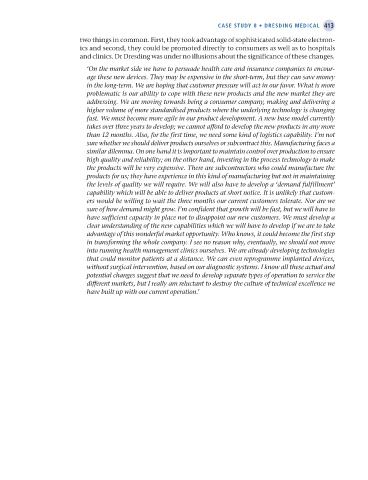Page 438 - Operations Strategy
P. 438
case study 8 • dresding medical 413
two things in common. First, they took advantage of sophisticated solid-state electron-
ics and second, they could be promoted directly to consumers as well as to hospitals
and clinics. Dr Dresding was under no illusions about the significance of these changes.
‘On the market side we have to persuade health care and insurance companies to encour-
age these new devices. They may be expensive in the short-term, but they can save money
in the long-term. We are hoping that customer pressure will act in our favor. What is more
problematic is our ability to cope with these new products and the new market they are
addressing. We are moving towards being a consumer company, making and delivering a
higher volume of more standardised products where the underlying technology is changing
fast. We must become more agile in our product development. A new base model currently
takes over three years to develop; we cannot afford to develop the new products in any more
than 12 months. Also, for the first time, we need some kind of logistics capability. I’m not
sure whether we should deliver products ourselves or subcontract this. Manufacturing faces a
similar dilemma. On one hand it is important to maintain control over production to ensure
high quality and reliability; on the other hand, investing in the process technology to make
the products will be very expensive. There are subcontractors who could manufacture the
products for us; they have experience in this kind of manufacturing but not in maintaining
the levels of quality we will require. We will also have to develop a ‘demand fulfillment’
capability which will be able to deliver products at short notice. It is unlikely that custom-
ers would be willing to wait the three months our current customers tolerate. Nor are we
sure of how demand might grow. I’m confident that growth will be fast, but we will have to
have sufficient capacity in place not to disappoint our new customers. We must develop a
clear understanding of the new capabilities which we will have to develop if we are to take
advantage of this wonderful market opportunity. Who knows, it could become the first step
in transforming the whole company. I see no reason why, eventually, we should not move
into running health management clinics ourselves. We are already developing technologies
that could monitor patients at a distance. We can even reprogramme implanted devices,
without surgical intervention, based on our diagnostic systems. I know all these actual and
potential changes suggest that we need to develop separate types of operation to service the
different markets, but I really am reluctant to destroy the culture of technical excellence we
have built up with our current operation.’
Z08 Operations Strategy 62492.indd 413 02/03/2017 13:46

